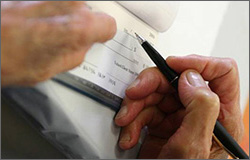Double Whammy: First the Scam. Then the Tax.
A law passed by Congress in 2017 contained fine print that is now delivering a financial shock to victims of fraud. With little fanfare, it eliminated the tax deduction for people who lose money in scams, and that is costing victims even more money. In a July U.S. District Court decision, a judge ruled that a retired couple owed federal taxes on nearly $2 million stolen from them by their daughter, who is now serving a 25-year sentence.
While Judge Tom Barber found his own ruling “astonishingly” odd, he based it on language in the 2017 law. According to the Washington Post, that law included provisions that were designed to capture tax revenue in the aftermath of big tax cuts that  were costing the U.S. Treasury billions of dollars. One section eliminated a tax deduction for theft – including scams. Other provisions eliminated deductions for money lost in earthquakes, fires and storms.
were costing the U.S. Treasury billions of dollars. One section eliminated a tax deduction for theft – including scams. Other provisions eliminated deductions for money lost in earthquakes, fires and storms.
Under that law, the tax deduction that used to be helpful to scam victims will be reinstated after 2025, although some lawmakers now oppose doing so. In the meantime, however, its absence is proving costly – and shocking – to individuals who have suffered elder fraud and other scams.
The Post reported, for example, that a Maryland retiree now owes more than $200,000 to the Internal Revenue Service after she was scammed by a crook who pretended to be a government official. “IRS just milks the money,” she told the newspaper. “…There is no mercy for little old ladies.”
In another example, the newspaper featured the story of a former White House scientist who lost $655,000 in life savings to a global, online criminal ring – and was then slapped with a six-figure tax bill from the IRS. The scammers tricked her into believing they were protecting her savings from fraud. After gaining her trust, they proceeded to clean out her assets including her retirement account.
Decades of savings went down the drain, severely harming her financial and emotional well-being. “I’m never going to stop feeling like it was my fault, because I made a stupid mistake, and I already paid a terrible price,” she told the newspaper.
The former scientist is not alone in facing the double whammy of scams – and taxes on scams. According to the Washington Post, taxpayers claimed $3 billion in “personal theft and casualty loss deductions” before the 2017 law, but by 2020 the amount of those claims had shrunk to about $600 million.
Xfinity Reports Major Data Breach
Telecom giant Xfinity recently informed customers of a data breach exposing personal information of nearly 36 million customers. Users’ names, contacts, secret questions and answers, and the last four digits of Social Security numbers were potentially captured – all of which can be exploited in identity theft.
In response, parent company Comcast told customers to change their passwords and establish “two-factor or multi-factor authentication,” which requires online users to use at least two ways to identify themselves before they can enter a website.  Comcast further advised customers who used the same password for Xfinity and for other, unrelated accounts, to change the password on their other accounts, as well.
Comcast further advised customers who used the same password for Xfinity and for other, unrelated accounts, to change the password on their other accounts, as well.
The breach occurred between October 16 and October 19 and affected 35,879,455 people, according to Comcast’s regulatory filing with the state of Maine’s attorney general. It was discovered on December 6, according to company officials who cited a vulnerability in software supplied by Citrix, a technology firm that supports Comcast’s website.
“You’ll get an alert if we detect possible fraudulent use of your information or find it on the dark web,” Comcast informed customers in an email. “If you become a victim of ID theft, we work to fix it,” adding: “We have your back.”
The breach has sparked multiple class action lawsuits aimed at Comcast and Citrix. One of the lawsuits complains that Comcast failed to protect people’s personal data, and another faults the company for leaving customers unaware that their private information was at risk for exposure.
Consumer Tip: Check Fraud is on the Rise
Even as paper checks are rapidly falling out of fashion with consumers, they are more popular than ever as a target for scammers who steal them out of mailboxes and deposit them in fraudulent accounts.
 In 2022, banks filed 680,000 reports of check fraud, according to the Financial Crimes Enforcement Network, which is in the U.S. Treasury Department. That number was almost double the 350,000 reports of check fraud in 2021. And this past November a separate report found that 31 percent of small business had experienced check fraud during the year, with losses often exceeding $50,000.
In 2022, banks filed 680,000 reports of check fraud, according to the Financial Crimes Enforcement Network, which is in the U.S. Treasury Department. That number was almost double the 350,000 reports of check fraud in 2021. And this past November a separate report found that 31 percent of small business had experienced check fraud during the year, with losses often exceeding $50,000.
It may seem odd that scammers are targeting a form of payment that seems to be following dinosaurs, landline phones, and black-and-white TVs into extinction. Credit cards, debit cards, and payment apps, which became more common during the pandemic, all take up a growing share of consumer transactions, as personal checks and U.S. currency play a diminishing role.
At the turn of this century, checks were used in 60 percent of noncash purchases and bill payments, according to the Washington Post. Nowadays, the figure is closer to 5 percent.
But checks have only grown in the interest of scammers. In a technique known as “check washing,” crooks remove checks from mailboxes and apply a chemical wash to erase the ink, enabling them to change names and dollar amounts on the check. (Scammers have been known to fish checks out of mailboxes with the help of glue traps meant to kill rodents, AARP reported.)
Once they capture and alter the check, the fraudsters deposit it in a bank account they control. They also may use copiers to create more phony checks. Stolen checks are being bought and sold online, in bulk, with the help of smartphone apps, the New York Times reported.
The U.S. Postal Service says it recovers more than $1 billion in “counterfeit checks and money orders” annually.
Consumers who write checks can take certain steps to reduce the risk of fraud, according to AARP. These include paying bills online; delivering paper checks to the Post Office, rather than dropping them in a mailbox; writing checks with blue or black nonerasable gel ink; collecting your own mail promptly from the mailbox; paying attention to your checking account; and reporting any problems to your bank right away.